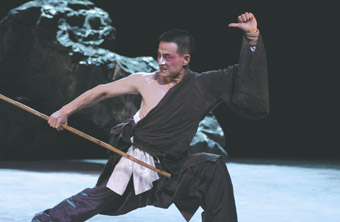classic transposition
bec tudor: ten days on the island: wu hsing-kuo’s king lear

Wu Hsing-kuo, Lear, Legend Theatre
courtesy of the artist
Wu Hsing-kuo, Lear, Legend Theatre
TO A CHAOTIC, CLASHING MUSICAL JANGLING, WU HSING-KUO ENTERS THE STAGE DRESSED IN A FLAMBOYANT CHINESE SILK ROBE DECORATED WITH RED FLAMES. HE JERKS AND ROCKS BACK AND FORTH ON HIS CURVED-SOLED PLATFORM BOOTS, FLINGING HIS MANE OF WILD HAIR AND FANNING A WAIST-LONG WHITE BEARD IN A COMIC DEMONSTRATION OF UNSTEADY, UNDIGNIFIED OLD AGE. ABOVE THE STAGE THE ILLUMINATED SUBTITLES READ: “ACT I: THE PLAY (KING LEAR).”
The chronology has been compressed. Lear is already on the heath, at the climax of his insanity triggered by his betrayal by daughters Goneril and Regan, and his regret at disowning Cordelia. One moment, enraged by his loss of respect, he yells: “Dost thou know me?” The next, however he plays peek-a-boo behind his sleeves, humorously embodying Goneril’s “old fools are babes again.”
In the tradition of Beijing Opera, the monologues in Contemporary Legend Theatre’s one-man production are spoken and sung in Mandarin. Little of the original play’s script is replicated verbatim and the audacious decision to rewrite Shakespearian dialogue demonstrates the confidence and creativity of this Taiwanese company, which aims to reinvigorate traditional art forms by recontextualising classic stories and producing genuinely intercultural productions.
There’s a surprisingly postmodern moment when Lear removes his wig and beard revealing Hsing-kuo underneath. “You’re not Lear!”, he tells these props, implicating himself—the actor who plays no less than eight characters in this performance—in this struggle for identity. Self-strangulation submerges Hsing-kuo’s personality and with a minor costume alteration he is transformed into the virtuous nobleman, Kent. Now he speaks of himself as Lear’s “shadow” and “storyteller.” Thus the brilliant weaving of metaphor and double meaning continues.
In Act Two, “The Playing (Fool)”, Hsing-kuo is a consummate jester, amusing us with a fast-paced mixture of physical comedy, linguistic riddles and irreverent impersonation. He sarcastically replays the situation that lead to the king’s demise, where daughters Goneril, Regan and Cordelia must declare they love their father best to get a cut of his kingdom. We know that Regan’s proclamation is a pernicious lie when, dressed in pink skirt, he parodies her moonwalking, flourishing a sequinned rag over her twitching shoulder and begging for a bigger “piece of meat.”
Hsing-kuo’s portrayal of the suicidal Gloucester and the fighting half-brothers, Edgar and Edmund, are equally engaging though more sober portraits. This superb singer, actor and movement artist commands the stage absolutely—as Act Three, titled “A Player: Wu Hsing-kuo”, explicitly acknowledges. In order to depict Lear mourning the needless death of Cordelia, the performer is pared back to his raw abilities. Wearing a simple black cloak, he speaks with unaffected voice and sings without the accompaniment of instruments. It’s a powerful portrayal of a man who has been stripped of everything.
The performance ends with Lear’s death, which is represented by his slow ascent into a column of icy light. This lifting of Hsing-kuo’s limp body from the stage was probably the only way my fixation on this truly amazing artist could be broken.
Contemporary Legend Theatre, Taiwan, King Lear, adapted from the play by William Shakespeare, director, performer Wu Hsing-kuo, Ten Days on the Island, Theatre Royal, Hobart, April 4-5
RealTime issue #91 June-July 2009 pg. 15






